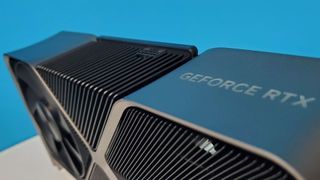Nvidia RTX 4070 rumoured to have same core counts as the old RTX 3070
Performance boost of new GPU will be purely down to clockspeeds.

Arguably the most reliable source of pre-release GPU specs, kopite7kimi, has tweeted some key numbers for Nvidia's upcoming GeForce RTX 4070 graphics card. The bad news is that the new GPU reportedly has exactly the same number of shaders, RT cores and render outputs as the old RTX 3070. So, the new 4070's performance jump could mostly be about clockspeeds.
The new GPU also is said to have more memory than the RTX 3070, with 12GB instead of 8GB, however. Nvidia may also have bumped the L2 cache from 4MB to 32MB. But most of the hardware specs are disappointingly similar to ye olde 3070:
5,888 FP32 shaders, 46 RT cores, and 64 ROPs. The one big change, therefore, is the chip's boost clock, now said to be 2,610MHz, a 51% leap over the 1,725MHz peak frequency of the RTX 3070. As ever, all this remains mere rumour, not official specifications from Nvidia.
However, kopite7kimi has an excellent track record when it comes to early looks at GPU specs. Moreover, these numbers all make sense in terms of what Nvidia has already announced from the RTX 40 Series, including the RTX 4090, RTX 4080 and the GPU formerly known as the RTX 4080 12GB, now cancelled and expected to resurface as CES in January rebranded as the RTX 4070 Ti.

Best CPU for gaming: The top chips from Intel and AMD
Best gaming motherboard: The right boards
Best graphics card: Your perfect pixel-pusher awaits
Best SSD for gaming: Get into the game ahead of the rest
By comparison to the numbers above, the RTX 4080 12GB was specced up at 7,680 shaders, 60 RT cores and 80 ROPS before Nvidia nixxed it, so any RTX 4070 rather than RTX 4070 Ti is a nailed-on certainty to come in below those figures. Hopefully we'll find out soon enough, as we're expecting both the 4070 Ti and the 4070 to be announced at CES in a month's time.
Anyway, a 50% bump over the last gen card is not to be sniffed at. But as will many of this latest generation of GPUs, we can't feeling it could have been much better still. Imagine not just 50% higher clocks but 50% more shaders, too. Oh, well. Maybe next time.
The biggest gaming news, reviews and hardware deals
Keep up to date with the most important stories and the best deals, as picked by the PC Gamer team.

Jeremy has been writing about technology and PCs since the 90nm Netburst era (Google it!) and enjoys nothing more than a serious dissertation on the finer points of monitor input lag and overshoot followed by a forensic examination of advanced lithography. Or maybe he just likes machines that go “ping!” He also has a thing for tennis and cars.
Most Popular







